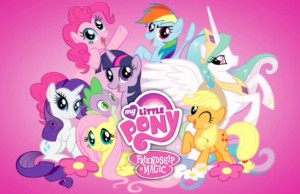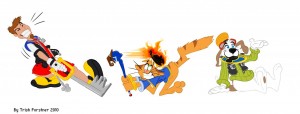Archive for category Television
The Surprising Cult-Popularity of My Little Pony
Posted by kjohnson1585 in Animation, Television, Uncategorized, Writing on February 7, 2011
What’s up with the sudden love for MLP?
For those not in the know, MLP stands for My Little Pony. For those really not in the know, the veritable toy line and 80s cartoon was rebooted under the name My Little Pony: Friendship is Magic in 2010 by Hasboro’s own network “The Hub,” to, er, essentially create a new toy line. While there’s nothing new here in conception, the result seems to have given birth to a host of cult fans across the internet, including a few fan forums and chat rooms filled with supporters constantly touting the show’s value. And the scary part is, they are full-grown adults.
Let’s slow down a moment. First, it’s important to emphasize the cult status of the show, especially since Internet popularity doesn’t exactly mean much in terms of the average consumer’s notion of popular culture. In addition, “Buy My Product” cartoons always carry a stigma of blatant financial pandering – a marketer’s paradise where kids line up to acquire action figures, dolls, bedspreads, key chains, pogs (pogs are still a thing, right?), and countless other pieces of merchandise – and maybe, just maybe, they’ll watch the cartoon on occasion.
I often take issue with those instantly dismissive of toy-based entertainment. Sure, it’s obvious that the primary drive is skewed towards the “toyetic” aspect of the franchise versus actually creating a quality cartoon; that doesn’t mean that the cast and crew can’t be dedicated enough to try and create a quality show/movie/comic regardless. Something that’s inherently property-based doesn’t automatically mean it’s shitty – see, Clue. And it’s pretty great to draw as much entertainment from My Little Pony as I would from something like Spongebob Squarepants.
It helps that the show is run by Lauren Faust, wife to Powerpuff Girl and Foster’s Home for Imaginary Friends creator Craig McCracken, whose influences are apparent (the relation between PPG and MLP is so obvious it isn’t worth exploring). Make no mistake, though: it is Faust’s creativity and design that shines through here, to the show’s ultimate benefit. MLP works carefully in defining distinct pony personalities, always an important element in large ensamble TV shows, particularly animated ones (were there any distinctive character in the original MLP or even something like Care Bears?). Its stories are simple but engaging, non-pandering, and disguise its life-lessons well enough in surprising, well-thought out plots and mythologies. It’s a great example of going all out with a simple idea, and reaping the rewards.
Still, it’s popularity is something of a mystery. We’re talking colorful, magical, bright-eyed ponies here, with situations that leave our protagonists afflicted with punned-based diseases, such as – are you ready? – Poison Jokes. (You see, it’s like Poison Oak, but afflicts you with a gag-based symptom.) And while that sounds cringe-inducing, it works very well with the show because of the cast’s commitment to the conflict. There’s no “cutesy-cooties” stories here, and no shoed-in lessons or random-academic facts. Pun aside, Poison Jokes is serious fucking business to the ponies.
Bright, fluid animation with (I assume) Flash and excellent voice talent elevates the show to another level of quality. Solid stories and great characters brings it up another notch (which makes it leagues above the “reptiles talking about nothing” monotony of Dragon Tales – the animated version of Gilmore Girls). However, I’d attribute one extra thing that really makes the show shine beyond more cartoons of a similar nature. You probably didn’t think of this, but this simple feature is what I think allows it to surpass the nature of simple kid’s interest and into genuine, adult-likeability:
Episodes are 22-minutes long.
It always surprises me that more modern-day cartoons don’t adhere to the full 22-minute time frame for an episode, opting to create two 11-minute shorts instead. I’m not referring to the Fox/Comedy Central ‘toons, which are more or less animated sitcoms (although Drawn Together blurred that line), nor to “action” cartoons, like your GI Joes, Transformers, or Marvel/DC animated programs. I refer to what Jeffery Scott in How to Write for Animation calls “squash-and-stretch” cartoons, your mid-day and early evening animation on networks like Nickelodeon or Cartoon Network: Angry Beavers, TUFF Puppy, Regular Show, Chowder, and so on. If an episode of shows like these use all 22 minutes for one self-contained story, it’s probably because it’s a special of some sort. Otherwise, you’re probably getting two shorts instead of one.
Granted, I can understand why it is done. Executives fear alienating the young audience by splitting a show into two parts through commercials. Also, it’s slightly easier to produce two shorts with a team of people (regulating directors and animators focusing on their proper specialties) than it is to collaborate an entire team to one full episode. Still, in the age of DVR and Youtube, and in a time when streamlining the workload is much cheaper and easier, squash-and-stretch cartoons ought to utilize their entire timeslot to the fullest.
Quite frankly, 22-minute episodes tend to be better than the 11-minute ones. The pacing is spread out better and jokes and movements aren’t as crammed together. We can learn about the characters more, get a sense of their personalities and their behaviors, as well as their interactions with each other. Think about it this way: squash-and-stretch cartoons use the 22-minute format during specials mainly to reveal “secrets” or “surprises” about the characters or their world – you know, that thing called “development”. If a squash-and-stretch cartoons worked off the 22-minute template every time, they could “develop” the characters and the world every time. A no-brainer.
The 2 x 11-minute template only leaves room for the story, under the belief that there isn’t a strong need to develop much else to the show besides the plot. With 22-minutes, characters can shine, the plot can create larger stakes, and the limits of the confined setting can be explored to its fullest potential (provided there isn’t any pointless padding). I’m personally not a huge Invader Zim fan, but I’ll admit that loved the pilot and it’s mid-season, planet-riding episode, both of which were 22 minutes. Phineas and Ferb mixes 1 x 22-minutes with 2 x 11-minutes episodes quite frequently, and while both formats are fun, the 1 x 22 have more going for it in terms of character, interactions, and aesthetics. There’s more energy. There’s more investment. There’s more commitment. And this is what I believe makes the My Little Pony show such a treat. Heck, it’s why Sesame Street and Blue’s Clues fairly entertaining to adults, too. It commits us to the entire episode of the show.
While I’ll avoid an entire episode analysis of what works here, a cursory glance at the first five minutes reveals quite a bit. In about thirty seconds, we learn about the two main characters, and a third who apparently controls the clouds. Right after – we hit the ground running with a conflict: all the ponies are in hiding. The plot begins quickly, a la a 11-minute cartoon. But the beats switches quickly to a vaguely sitcomy-type development. In the darkness of the house, we learn point-blank how each pony works and thinks; different voices, actions, behaviors and reactions to this “zebra” illicit similar fears but different responses to that fear. We learn (quite comically, but paramount to in-world development) that they exist in a realm that finds the laws of nature strange, crude, and barbarically horrific. And instead of moving towards the episode climax, the stakes are ratcheted up even higher when the younger pony strikes out on her own to confront this strange striped creature. In essence, we have all the quick-to-the-punch elements of typical 11-minute cartoon, the character-interplay and pacing of a sitcom, and the diegetic development and rising conflict notorious to action cartoons. People may say the writing is good, but it’s because of that 22-minute time frame that the writing can be particularly stellar in conception and execution (bare in mind, the plots are still inherently simplistic, but they go the extra mile to make them appealing).
I’m not rushing to catch every episode, but of the three I have seen, I found myself endeared to the tale being told, mainly because very little of the running time is wasted. Ratcheting up the conflict, keeping the characters distinct and unique (and giving everyone a fair amount of screen time – no one seems wasted), and maintaining those cartoon roots leaves My Little Pony: Friendship is Magic an entertaining, if not too deep, piece of television delight. For comparison, this episode is more sitcomy in plot (a creative take on the other friend replacing you plot-trope), while this one is a more basic, cartoony story (given a harrowing if silly climax). The mixture of elements would be a mess in short form, but 22-minutes is perfect; or should I say, 22-minutes is magic.
More great concept art
Posted by kjohnson1585 in Animation, Television, Uncategorized, Video Games, Webtoon, Writing on December 16, 2010
A piece of concept art I had commissioned from the talented nanook123 (Trish Forstner) at Animated Visions:
One of the elements that will be strongly encouraged in the webtoon is the inclusion of smart video game based gags, jokes that go beyond the simplistic and almost insulting types of VG jokes used on most TV shows. (They tend to keep jokes focused on the overall video game aesthetic (running and jumping) and keep to obvious parodies of Pac-Man, Super Mario, Asteroids, Sonic the Hedgehog, and Frogger.)
Since we know that a large percentage of the population play games MODERN games like Fallout, Left 4 Dead, Uncharted, Bioshock, and Kingdom Hearts – I hope to allow plots and stories that homages/parodies these very well-known games, without coming off as pandering.
Beyond that, though, it’s cute, and I think the piece is amusing without fully understanding the game this piece is parodying.
I hope to make one more regular blog update before the New Year.
Brief update: Networking
Posted by Admin in Animation, Television, Uncategorized, Writing on November 12, 2010
Again, apologies to the lack of updates. I’ve been focused on the webtoon, and now I’ve been “working the scene”. Most “normies” call it networking.
Networking is ultimately a skill, made all the more inconvenient and troublesome when it requires taking time out your day or week to travel great distances to large gatherings. It’s hard to get your voice out there among the crowds, to manage and establish face-to-face time, and create a rapport that can sustain itself well after its over. It’s maintaining connections through emails, twitter accounts, blogs, Skype calls, and even MORE face-to-face meetings. It requires traveling, moving, handshaking and smiles, listening and communication and making large impressions. It’s a lot of work, mostly out of your own dime and time.
I have a love/hate relationship with networking. It used to be a hate/hate relationship; the first hate turned into love once I gained some confidence and embraced my overall love for traveling, meeting people, and drinking beers (alcohol is a great ice-breaker). Still, there’s something off-putting about the idea of networking being so prevalent a method for creating and discovering job opportunities. It would be fine if it was simply on par for the course, but networking has become ipso facto the way to make it in. The problem is that it actually has nothing to do with the quality of work or the individual. Quality people and products should stand on its own. But hacks and shoddy material make the most headway because of individuals who can talk a good game, and manage to be in the right place at the right time. Wonder why there’s so much crap in Hollywood? Because a guy knows a guy who knows a guy, and no one can say “No, this is a stupid idea” to a winning smile.
But I’ve come to accept this truth, and I’m hoping I can provide a winning smile as well as a genuinely enjoyable webtoon and future scripts that people actually enjoy. I have another event this Saturday. Gotta brush the pearly whites.
Here’s a bunch of networking contact info of mine:
My Facebook: http://www.facebook.com/profile.php?id=501651
My LinkedIn: http://www.linkedin.com/in/kevinjohnson1585
My Twitter: www.twitter.com/kjohnson1585
And here are some links to friends of mine’s Facebook pages. Be sure to especially be a fan of Joe Murray, Frog in a Suit, and KaboingTV!
Joe Murray’s Facebook: http://www.facebook.com/JoeMurrayStudio
KaboingTV Facebook: http://www.facebook.com/KaboingTV
Frog in a Suit Facebook: http://www.facebook.com/froginasuit
I’ll be back to posting long-winded analysis of stuff very soon!




